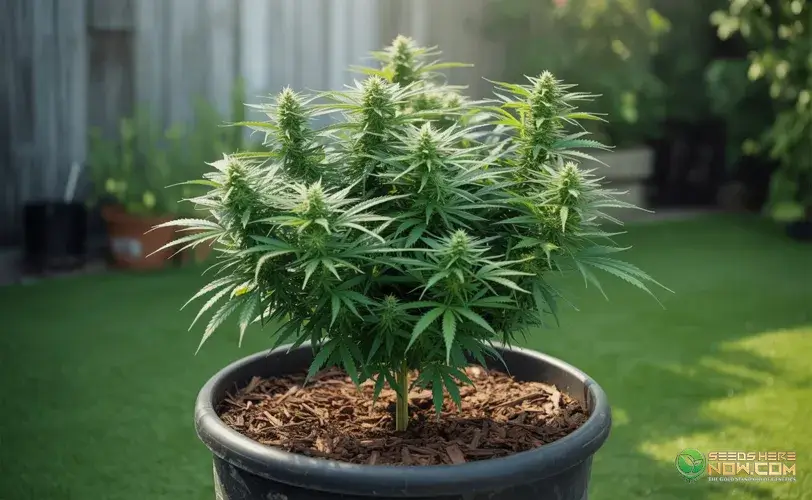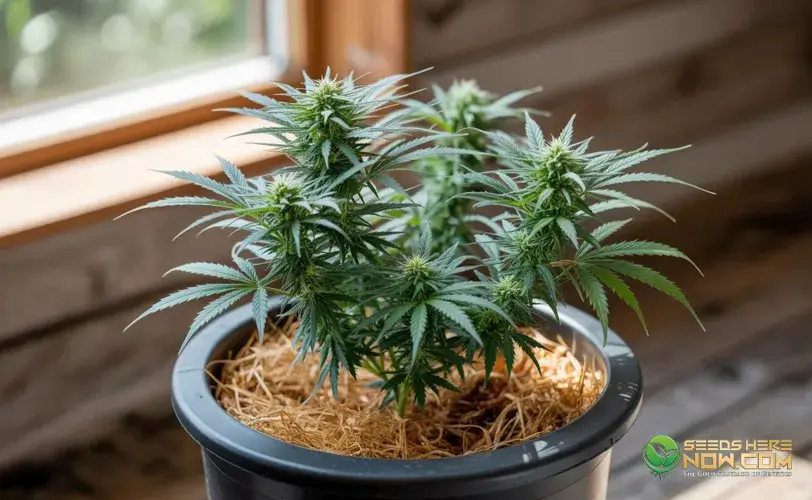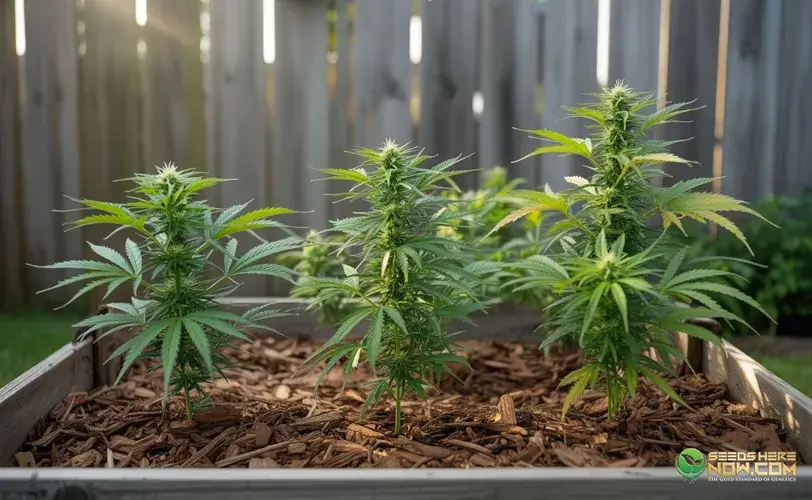Best Mulch for Cannabis: A Complete Grower’s Guide

When it comes to cultivating cannabis, mulch is often the unsung hero. By regulating temperature, retaining moisture, and improving soil quality, mulch creates an optimal environment for root health and overall plant vitality. Whether you’re growing outdoors or in a controlled indoor setup, choosing the best mulch for cannabis can boost yields and improve plant resilience.
This guide walks you through the types of mulch best suited for cannabis, the benefits of using mulch, how to apply it, and common mistakes to avoid.
Why Mulch Matters for Cannabis Plants
Mulching isn’t just for ornamental gardens—it’s a strategic move for cannabis growers. Here’s why mulch deserves a spot in your grow plan:
-
Moisture retention: Reduces the frequency of watering
-
Weed suppression: Blocks light from reaching weed seeds
-
Temperature regulation: Insulates soil against extreme heat or cold
-
Soil health: Organic mulches break down and enrich soil
-
Pest deterrence: Some mulches help deter pests and insects
Mulch acts as a natural buffer, shielding your cannabis roots from environmental stress.
Types of Mulch for Cannabis: Pros, Cons, and Pro Tips
Choosing the right mulch depends on your cultivation style, local climate, budget, and long-term goals for soil health. Below is an in-depth look at popular mulch types used by cannabis growers, including how each one performs and when it’s most appropriate.
Straw Mulch
Overview
Straw is one of the most commonly used mulches in organic cannabis cultivation. It’s made from the dry stalks of cereal grains like wheat, barley, or oats, after the seed heads have been harvested.
Pros
-
Retains moisture efficiently, reducing watering frequency
-
Light and airy, allowing good airflow to the soil
-
Breaks down over time, adding organic matter
-
Affordable and widely available
Cons
-
If not properly sourced, it may contain weed seeds
-
Needs replenishment each grow cycle
-
Attracts rodents or pests in some outdoor environments
Pro Tips
-
Use weed-free or certified organic straw to avoid unwanted seeds.
-
Apply a 2- to 4-inch layer around the base of the plant, leaving a gap near the stem.
-
Works especially well in outdoor, raised bed, or no-till systems.
Compost or Aged Manure
Overview
Compost and aged manure are nutrient-rich materials that serve both as mulch and as a slow-release fertilizer. Compost is made from decomposed plant matter, while aged manure comes from animals such as cows, horses, or chickens.
Pros
-
Excellent for building soil structure and microbial life
-
Encourages strong root development
-
Improves drainage and aeration
-
Suppresses weeds when applied in thick layers
Cons
-
Fresh or improperly aged manure can burn plants due to high nitrogen
-
Compost can compact if not fluffed or mixed
-
May have an unpleasant odor during early application
Pro Tips
-
Only use fully aged or hot-composted manure to prevent root burn.
-
Use as a top dressing or mixed lightly into the upper inch of soil.
-
Combine with straw or wood mulch to balance nutrient load and texture.
Wood Chips or Bark Mulch
Overview
These mulches are made from shredded or chipped wood—often hardwoods like oak or pine—and provide long-term ground coverage. Bark mulch is often finer and more uniform in texture.
Pros
-
Long-lasting and slow to decompose
-
Suppresses weeds and conserves moisture
-
Aesthetically pleasing for landscaped cannabis gardens
-
Insulates roots from extreme temperature swings
Cons
-
Fresh chips may rob nitrogen from the soil as they decompose
-
Can become compacted or waterlogged if over-applied
-
Not ideal for young seedlings or shallow-rooted plants
Pro Tips
-
Use aged or composted wood chips to avoid nitrogen drawdown.
-
Best applied in the pathways of outdoor grow beds or around large, mature plants.
-
Combine with nitrogen-rich compost to offset any nutrient competition.
Cocoa Hulls
Overview
Cocoa hulls are the outer shells of cocoa beans and serve as a nutrient-rich and attractive mulch.
Pros
-
Sweet, chocolatey aroma (unless wet and molding)
-
Adds potassium and phosphorus as it breaks down
-
Lightweight and easy to spread
-
Retains moisture and regulates temperature
Cons
-
Toxic to dogs and cats if ingested
-
Can become moldy in humid or poorly ventilated spaces
-
More expensive and harder to source than straw or compost
Pro Tips
-
Ideal for indoor grows or greenhouses where pets aren’t present.
-
Apply a thin 1- to 2-inch layer to avoid moisture build-up and mold.
-
Mix with other mulches to dilute cost and prevent clumping.
Living Mulch (Cover Crops)
Overview
Living mulches consist of low-growing, fast-spreading plants like white clover, alfalfa, or vetch that grow alongside your cannabis.
Pros
-
Adds biodiversity and natural pest control
-
Fixes nitrogen into the soil (especially legumes like clover)
-
Reduces erosion, compaction, and runoff
-
Improves soil aeration and organic matter
Cons
-
Requires proper management to avoid competition for nutrients
-
Needs regular mowing or termination
-
Can harbor pests or disease if allowed to overgrow
Pro Tips
-
Seed living mulch a few weeks before planting cannabis, or between rows.
-
Terminate with a crimp roller or by cutting at soil level once plants mature.
-
Best suited for regenerative, no-till, or permaculture systems.
Hay
Overview
Hay is a cut of grasses or legumes that often contains seed heads and more green matter than straw.
Pros
-
High in nutrients and adds organic matter
-
Retains moisture and insulates roots
-
Readily available and inexpensive
Cons
-
Frequently contains weed seeds
-
Can become slimy or moldy if wet
-
Breaks down faster than wood or bark
Pro Tips
-
Choose old or sun-dried hay to reduce seed viability.
-
Use for short-term mulch needs or cover crop kill layers.
-
Layer thinly and combine with straw for better structure and airflow.
Plastic Mulch or Landscape Fabric
Overview
These synthetic materials are used for large-scale or commercial grows and act as a weed barrier while conserving moisture.
Pros
-
Excellent weed suppression
-
Reduces evaporation in arid regions
-
Reflective plastics can increase light exposure for lower canopy
-
Minimal maintenance required
Cons
-
Does not contribute to soil health
-
May overheat root zones in hot weather
-
Not biodegradable; needs to be removed after harvest
-
Can restrict water penetration if improperly installed
Pro Tips
-
Use white or reflective plastic in hot climates; black plastic in cooler zones.
-
Pair with drip irrigation systems to maintain consistent watering.
-
Cut X-shaped holes for each plant to allow breathing space at the base.
Coco Coir Mulch
Overview
Coco coir mulch is made from the fibrous husks of coconuts and is available as loose fibers or mats.
Pros
-
Excellent water retention and aeration
-
Naturally resistant to mold and fungi
-
pH-neutral and sterile
-
Sustainable and renewable resource
Cons
-
Lacks nutrients unless amended
-
More costly than straw or bark
-
May compact if overwatered
Pro Tips
-
Ideal for container-grown or hydroponic cannabis.
-
Use in combination with dry organic matter like worm castings for a nutrient boost.
-
Rinse thoroughly before use to remove salts if not pre-washed.
Honorable Mentions
-
Leaf litter: Free and readily available in the fall, but may attract pests.
-
Pine needles: Useful for acid-loving plants, though not ideal for cannabis due to their low pH.
-
Newspaper/cardboard: Good for sheet mulching and weed control, especially when covered by straw or compost.
How To Apply Mulch for Cannabis
Proper mulching goes beyond throwing material on the ground. Here’s how to do it right:
-
Clear the surface: Remove weeds or debris from the soil surface.
-
Water first: Ensure soil is moist before adding mulch.
-
Apply evenly: Spread 2 to 4 inches of mulch around the base of your cannabis plants.
-
Avoid the stem: Keep mulch a few inches away from the main stalk to prevent rot.
-
Replenish as needed: Organic mulch breaks down over time—add more as necessary.
Tips for Using Mulch in Cannabis Gardens
-
Don’t overdo it: Too much mulch can suffocate the roots or lead to fungal issues.
-
Use organic options when possible: These improve soil biology and reduce waste.
-
Pair with drip irrigation: This combo boosts water efficiency in outdoor grows.
-
Consider mulch color: Light-colored mulches reflect heat, while dark mulches absorb it.
-
Monitor for pests: Mulch can harbor pests—check regularly for infestations.
Mulch and Soil Temperature: What Growers Should Know
Soil temperature affects everything from seed germination to nutrient uptake. Mulch helps buffer temperature swings, keeping roots in a stable, productive range.
In hot climates, light mulches like straw help cool the soil. In cooler regions, dark mulch retains heat and extends growing seasons.
Frequently Asked Questions
What is the best mulch for cannabis in pots?
Coco coir, straw, or compost are excellent for container-grown cannabis. These options offer great insulation without compacting the medium.
Can I use grass clippings as mulch?
Yes, but only once dried. Fresh clippings can overheat and promote mold or rot.
Is mulch necessary for cannabis?
While not required, mulch significantly improves water retention, root health, and yield, especially in outdoor grows.
How often should I replace mulch?
Organic mulch breaks down over time and should be topped off every few weeks or between grow cycles.
Final Thoughts: Choosing the Best Mulch for Cannabis
The best mulch for cannabis depends on your growing environment, goals, and budget. For most organic growers, straw, compost, and living mulches offer the best balance of soil health and plant performance. Meanwhile, synthetic mulches may be suitable for commercial operations focused on efficiency and weed suppression.
Mulch isn’t just a passive layer—it’s an active part of your plant’s environment. By selecting the right mulch and applying it correctly, you create a thriving ecosystem that supports healthy cannabis from seed to harvest.
Want more cannabis cultivation tips? Visit our blog for hundreds of guides on growing, harvesting, and curing your best crop yet.
Suggested Articles
;)
;)
;)







 21 Dec 2025
21 Dec 2025  9 min read
9 min read


 August 05, 2025
August 05, 2025 


RESPONSES (0)
No responses yet. Be the first to respond!